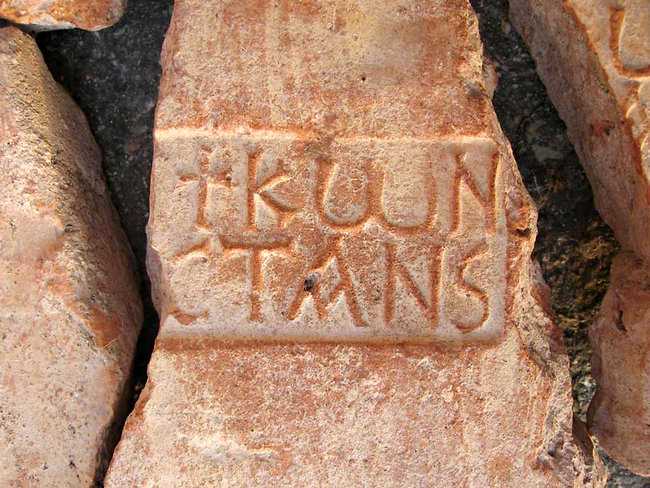By JENNIFER PINKOWSKI
ISTANBUL — For 1,600 years, this city — Turkey’s largest — has been built and destroyed, erected and erased, as layer upon layer of life has thrived on its seven hills.

Haldun Aydingun
BUILDING BLOCKS Hundreds of bricks stamped “Konstans,” made in Constantinople starting in the fifth century, were found at Bathonea.
Today, Istanbul is a city of 13 million, spread far beyond those hills. And on a long-farmed peninsula jutting into Lake Kucukcekmece, 13 miles west of the city center, archaeologists have made an extraordinary find.
The find is Bathonea, a substantial harbor town dating from the second century B.C. Discovered in 2007 after a drought lowered the lake’s water table, it has been yielding a trove of relics from the fourth to the sixth centuries A.D., a period that parallels Istanbul’s founding and its rise as Constantinople, a seat of power for three successive empires — the Eastern Roman, Byzantine and Ottoman.
While there are some historical records of this early period, precious few physical artifacts exist. The slim offerings in the Istanbul section of the Archaeological Museums here reflect that, paling in comparison with the riches on display from Anatolia, Mesopotamia and Lebanon.
So Bathonea (pronounced bath-oh-NAY-uh) has the potential to become a “library of Constantinople,” says Sengul Aydingun, the archaeologist who made the initial discovery.
After the drought exposed parts of a well-preserved sea wall nearly two and a half miles long, Dr. Aydingun and her team soon saw that the harbor had been equipped with docks, buildings and a jetty, probably dating to the fourth century. Other discoveries rapidly followed. In the last dig season alone, the archaeologists uncovered port walls, elaborate buildings, an enormous cistern, a Byzantine church and stone roads spanning more than 1,000 years of occupation.
“The fieldwork Sengul has conducted over the last few years is spectacular,” said Volker Heyd, an archaeologist at the University of Bristol in England who surveyed Bathonea for two field seasons. “The discoveries made are now shedding a completely new light to the wider urbanized area of Constantinopolis. A fantastic story begins to unveil.”
In 2008, for example, Hakan Oniz, an archaeologist from Eastern Mediterranean University who specializes in underwater research, investigated a structure in the lake that local lore held was some kind of mystical minaret that appeared and disappeared in relation to the rate of sinful behavior by nearby villagers. The ruins, about 800 feet from shore, may have been a lighthouse.
Since then, Dr. Aydingun’s team and researchers from eight foreign universities have found a second, older port on the peninsula’s eastern side, its Greek influences suggesting that it dated to about the second century B.C.
Nearby, atop the round foundations of a Greek temple, they found the remains of a fifth- or sixth-century Byzantine church and cemetery with 20 burials, and a large stone relief of a Byzantine cross. Coins, pottery and other artifacts indicate that the church suffered damage in the devastating earthquake of 557 but was in use until 1037, when a tremor leveled it — crushing three men whose bodies were found beneath a collapsed wall, along with a coin bearing the image of a minor emperor who ruled during the year of the quake.
After bushwhacking through nettle-choked underbrush a mile and a half north of the harbor, the researchers excavated a 360-by-90-foot open-air cistern or pool, as well as walls and foundations from several multistory buildings that may have been part of a villa or palace altered over many centuries.
Because the archaeologists are at the beginning of a multiyear dig at a site not known from historical sources, they are hesitant to draw many conclusions. Even the name Bathonea is a placeholder, inspired by two ancient references: the first-century historian Pliny the Elder’s “Natural History,” which refers to the river feeding the lake as Bathynias; and a work by a ninth-century Byzantine monk, Theophanes, who called the region Bathyasos.
“There is a big question mark over the name,” Dr. Aydingun said. “It’s too early to say. But the name is not important. The important thing to note is that there are buildings, roads” where “people thought there was nothing.”
“But there’s something there,” she went on. “We need a lifetime to discover what it is. But even by next year, we’ll be able to say more.”
A version of this article appeared in print on January 24, 2012, on page D1 of the New York edition with the headline: After Being Stricken by Drought, Istanbul Yields Ancient Treasure.
via Istanbul Yields a Treasure Trove in Ancient Bathonea – NYTimes.com.
More :

Leave a Reply